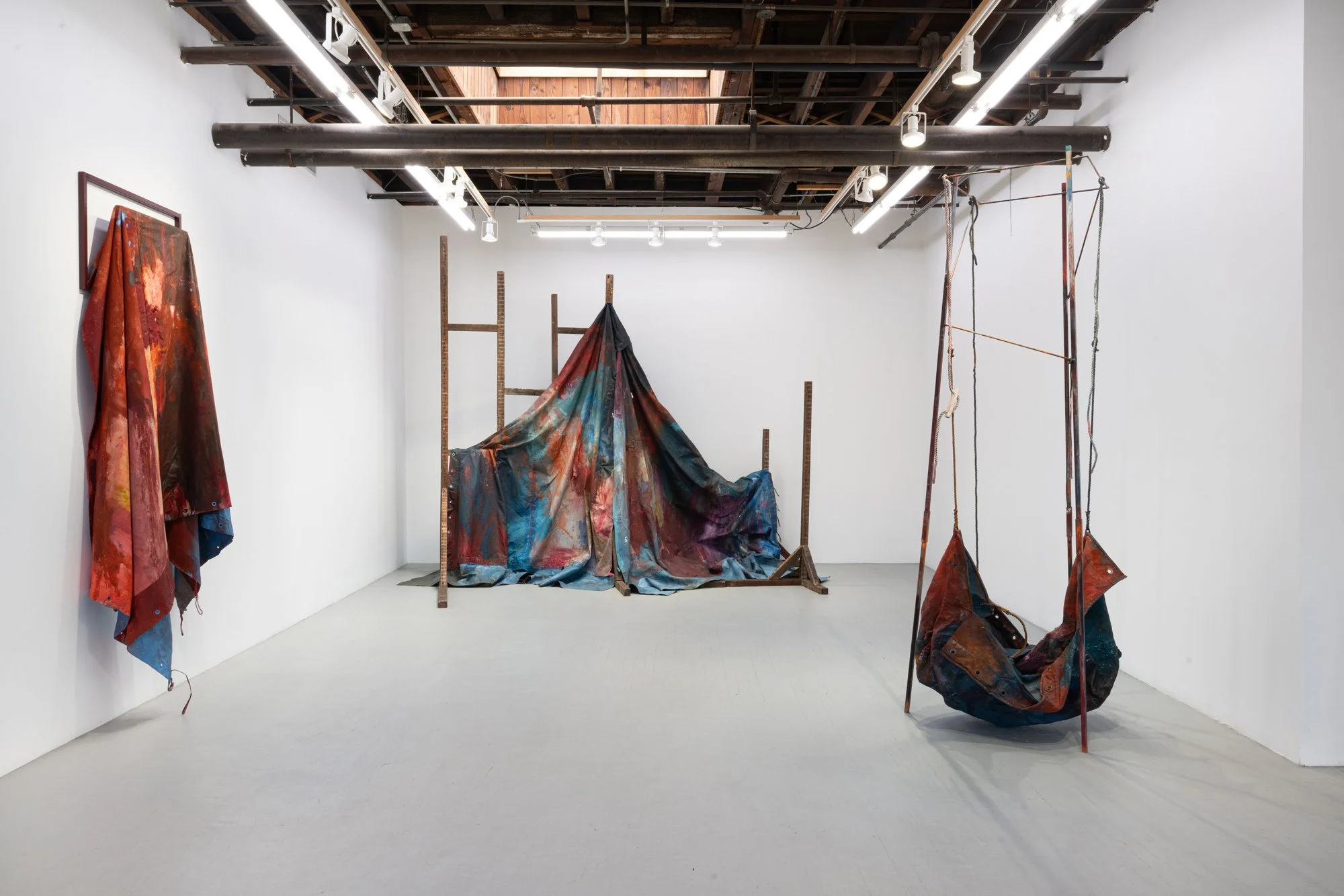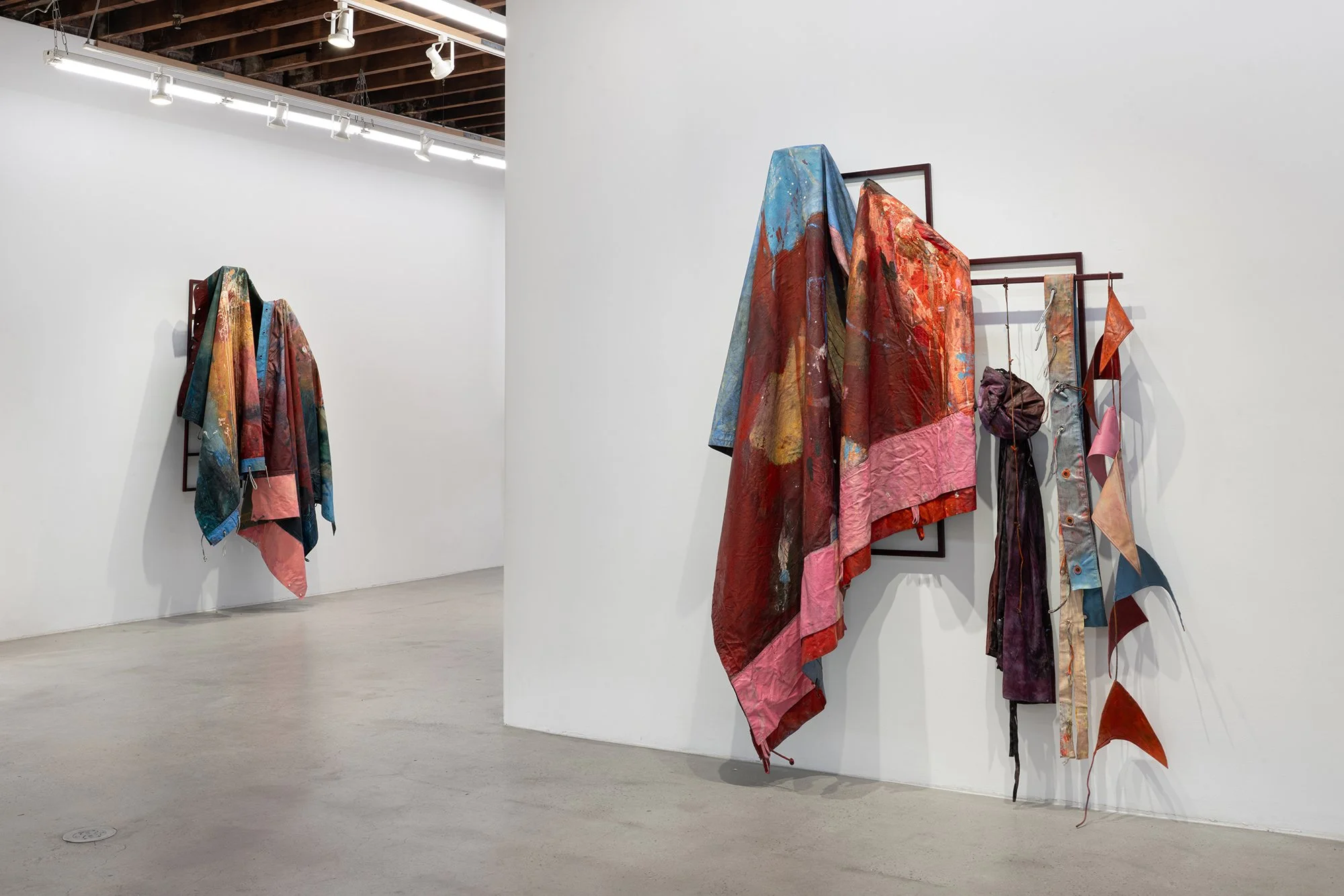JO DENNIS
A LETTER TO MY DAUGHTER
ON VIEW NOVEMBER 15, 2025 — JANUARY 3, 2026
A ruin carves beauty out of destruction. What was once whole and functional has been broken apart, deserted and lost its original use. The lives and histories that passed through the property, and unknowingly intersected, suddenly come alive. Ruins appear haunted; the delineations between life and death, form and fragmentation, are no longer absolute. This is why ruins are often considered sites of fantasy, transgression and play. At the same time, ruins are born out of cycles of industrial revolution and devolution, capitalist development and the ceaseless pursuit of profit; they are what remains of cities afflicted by war. The ruin as a stage for possibility and the unexpected, as well as a form of testimony to political crisis, shadows the family of sculptures in Jo Dennis’s first solo presentation of her work exclusively in this discipline.
Each sculptural assemblage is comprised of found materials and objects that carry the weight of their abandoned lives. Like us, they have memories. Dennis tells me that she sources military tents from the North of England, and when they arrive at the studio, they’re covered in mud. Their memory of that landscape and their former function as shelters against its inhospitable weather leaves a palpable material trace. Dennis washes the fabric carefully before she begins to paint. But the sculptures that arise from this process remember their origins in small yet evocative details. Zips, buckles, rivets, fastenings and toggles that once gave the tent its three-dimensional shape remain visible at the sculptures’ edges. On fabric that now recalls sumptuous Renaissance drapery, they are moments of recognition, an abstract visual language of their own, distinct from the painterly gestures that cover the surface they frame. These structural elements remind us where the tent might be entered and give the sculptures the feeling of dens—the haphazard, furtive sanctuaries of childhood—even in their current state, in which fabric clings to the wooden and metal spokes with an air of dilapidation.
Betty is the largest of these sculptures. With its skeleton of reclaimed wood, across which the painted fabric is draped, apparently succumbing to gravity—but still retaining the basic triangular form of the tent, as though this were too ingrained a characteristic to forget—it has the feel of a makeshift home. Dennis is partly referencing the Victorian houses in Southeast London where she has spent most of her adult life, the spectacle of encountering these once grand architectures midway through their demolition, the plasterboard ripped back to reveal the precarious lattice of stud walls. The spectre of austerity and gentrification, the failure of British social housing that left the homes that Dennis sources her materials from derelict, haunts these sculptures.
The title, however, names a woman, the American model and actress Betty Grable who died the day Dennis was born. A house falls into ruin through the passage of time and neglect; can the same be said of a woman? In a society that dictates a punishingly narrow norm of desirability as the metric by which women’s value is judged, ageing can feel like a devastating loss of meaning and visibility. In Betty, however, ageing might be understood not as a laying waste of form, but as a formal progression, a shapeshifting in which some features are stripped back and others are revealed. Betty—with its grand scale and deep, sensual colour palette—rages against the impositions on women to be smaller and quieter as they cease to please the male gaze. What if we understood women’s greater experience in life not as an impairment, but something which puts them into heightened contact with their mortality, and makes them more compelling, mysterious and powerful?
In Beast of Burden, a metal clothing rail is strung with found objects (amongst them bunting, pillowcases filled with sand, a nightshirt) covered, dipped or smeared in paint that resembles a post-apocalyptic sludge. The term refers to working animals who carry goods, but Dennis has described it as a self-portrait. Dennis is not alone in identifying with this figure of responsibility and exhaustion, an affinity that is not just relevant to women, who continue to do more emotional work than is their due. Who has not lately shared in this work’s feeling of abjection and desperation when reading the news? Each chain, hook, swatch of fabric and length of twill that Dennis places upon the knackered yet sturdy rail poses the same question: how much more do we take?
The title Cat’s Cradle refers to the game in which players take turns to produce different string figures between their fingers. An echo of these improvised, temporary shapes underpins the structure and general precariousness of the sculpture, as though a large hand might swoop in and rearrange its coordinates at any moment. A dishevelled bag sits between its three metal poles and creates a shape reminiscent of a baby’s cradle. There is a dark, brooding quality to the empty space within. Any playfulness carried over from the title is undercut by an intense and ambiguous melancholy.
The Maiden, a wall mounted sculpture, one of four in this presentation, is another work that plays upon the double meaning of its title. Maiden as a term for a woman, and as a wooden drying rack that can be placed in front of a fire: each suggest a form of womanhood aligned with traditional domesticity—making a home. Questions about who has historically been responsible for the home and who is now denied access to it come through in the now familiar language of military tent fabric, bunting, rope, and toggles. As in Beasts of Burden and Betty, connections are drawn between tents and women, homes and their inhabitants. Across Dennis’s urgent, moving sculptures, we are asked to consider the human relationships imbedded in material histories, as inextricable from being as the body itself.
Jo Dennis’s A Letter to my Daughter marks the artist’s first solo gallery exhibition in New York. Opening the evening of November 15, with the artist in attendance, this body of work is on view through January 3, 2026, at CARVALHO.
Essay by Rebecca Birrell, PhD
Jo Dennis (b. 1973, Forres, Scotland) lives and works in London. Her practice spans two decades, working across painting, sculpture, photography, and installation. Dennis received her MA in Painting from the Royal College of Art, London (2022) and a BA in Fine Art and Contemporary Critical Theory from Goldsmiths College, London (2002). Alongside A Letter to my Daughter at CARVALHO, Dennis is featured in The Long Now celebrating forty years of the Saatchi Gallery, London, and has an upcoming solo at Belenius Gallery, Stockholm (2026). Recent solo exhibitions include A Glass of Absinth at JO-HS, Mexico City (2025), Town Hall Disco at Newchild, Antwerp (2023), and a solo booth at The Armory Show with JO-HS Gallery (2025). Dennis is a recipient of a Grants for the Arts from Arts Council England (2023-24). She is the cofounder of several artist-led projects in London: Pigeon Park, Peckham 24 Photo Festival, AMP Gallery, and Asylum Chapel. She collaborated with Sid Motion Gallery on five solo projects (2017-2023), including the launch of her artist's book, I touched this with my hand, I touched that with my eye (2020). Dennis is a trustee of the Artists General Benevolent Institute. Her work was included in The Book of Ladders, 100 Contemporary Art Works, edited by Paul Carey Kent and Adeline de Monseignat (2023), and Site Specific by Tall Poppy Press (2023).











